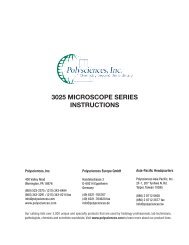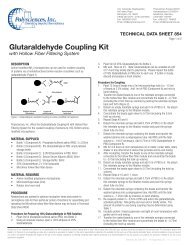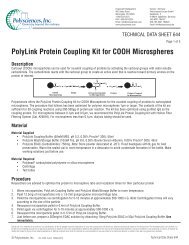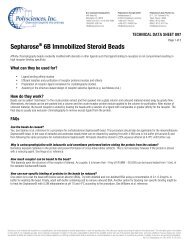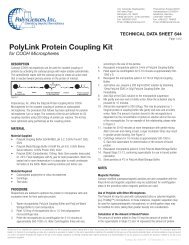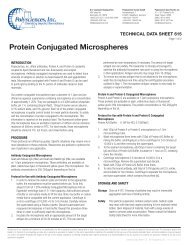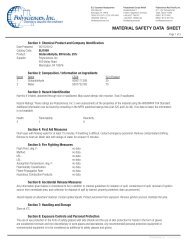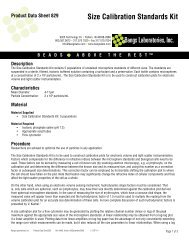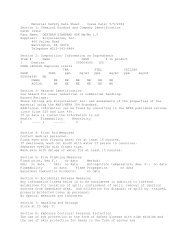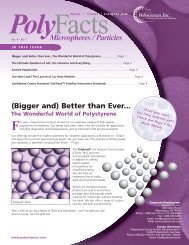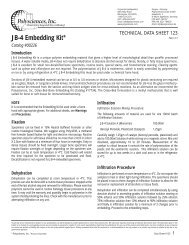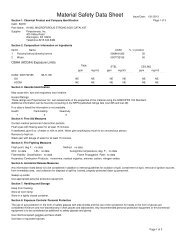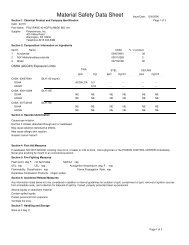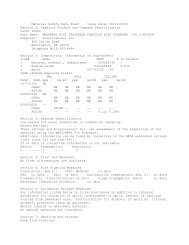Monomers Product Guide - Polysciences, Inc.
Monomers Product Guide - Polysciences, Inc.
Monomers Product Guide - Polysciences, Inc.
Create successful ePaper yourself
Turn your PDF publications into a flip-book with our unique Google optimized e-Paper software.
<strong>Monomers</strong><br />
Catalog #<br />
Crosslinking Acrylic <strong>Monomers</strong> - Multifunctional<br />
Typically used for generating highly crosslinked polymer structures, these monomers increase polymer toughness, modulus and solvent<br />
resistance. For UV curable formulations, multifuntional acrylates are typically faster reacting than their methacrylate analogs.<br />
Dipentaerythritol pentaacrylate<br />
(mixture of tetra-, penta-, hexaacrylate)<br />
Polymerizable<br />
Sites<br />
Add’l. Reactive<br />
Functionality Special Features<br />
multiple high crosslinking efficiency 16311-500 500 g 139<br />
Pentaerythritol tetraacrylate multiple 01547-100 100 g 152<br />
Pentaerythritol triacrylate tri hydroxyl multifunctional crosslinker 04259-100 100 g 152<br />
1,1,1-Trimethylolpropane triacrylate tri useful for UV cure 02658-250 250 g 158<br />
1,1,1-Trimethylolpropane trimethacrylate tri useful for UV cure 02659-250 250 g 158<br />
Size<br />
Dual Reactive Acrylic <strong>Monomers</strong><br />
It is often desirable to synthesize polymer architectures that are capable of further reaction to incorporate new functionality, graft new<br />
polymer chains, attach drugs or biomolecules, or make the polymer respond intelligently to changes in its environment. This diverse set<br />
of monomers have easily polymerizable carbon-carbon double bonds yet contain a secondary reactive group that can be elaborated in a<br />
multitude of ways. Some reactive groups e.g., carboxylic acid in o-nitrobenzyl methacrylate (Cat. #24360) are masked and are revealed<br />
by simple deprotection schemes.<br />
Add’l. Reactive<br />
Functionality<br />
Special Features<br />
Acrylic anhydride min. 90% anhydride (protected) allows formation of cyclic anhydrides 00488-50 50 g 128<br />
4-(2-Acryloxyethoxy)-2-<br />
hydroxybenzophenone<br />
phenol<br />
benzophenone is a strong UV absorber,<br />
potential UV radical initiator<br />
N-Acryloxysuccinimide ester (protected) derivitization through ester link using mild<br />
reaction conditions, good for biologically<br />
active compounds<br />
Allyl methacrylate olefin allyl double bond is less reactive than<br />
methacrylate, good for post polymerization<br />
reactions<br />
2-Aminoethyl methacrylate hydrochloride,<br />
min. 95%<br />
amine (as HCl salt)<br />
can be used to prepare polymers with amine<br />
functionality<br />
N-(t-BOC-aminopropyl)methacrylamide amine (protected) t-BOC easily deprotected to yield primary<br />
amine<br />
N-(3-Aminopropyl)methacrylamide<br />
hydrochloride, >98%<br />
amine (as HCl salt)<br />
can be used to prepare polymers with amine<br />
functionality<br />
2-Bromoethyl acrylate, min. 95% halogen allows synthesis of heavy atom polymers, Br<br />
can be displaced with various nucleophiles<br />
N-(iso-Butoxymethyl)methacrylamide,<br />
min. 95%<br />
tert-Butyl acrylate<br />
2-(tert-Butylamino)ethyl methacrylate,<br />
min. 90%<br />
19931-10 10 g 128<br />
19930-1 1 g 128<br />
01643-500 500 g 129<br />
21002-10 10 g 129<br />
24318-10 10 g 129<br />
21200-5 5 g 129<br />
02015-10 10 g 132<br />
oxo-methylene acid + heat catalyzed crosslinking monomer 19221-100 100 g 133<br />
carboxylic acid<br />
(protected)<br />
amine (secondary)<br />
used in photoresist formulations 02039-250 250 g 133<br />
builds polymers with secondary amines,<br />
potential H-Bonding sites<br />
01797-100 100 g 134<br />
2-Carboxyethyl acrylate, 90% carboxylic acid lower volatility analog to acrylic acid 16719-100 100 g 134<br />
2-Cinnamoyloxyethyl acrylate a, b unsat. ester photocrosslinking monomer 24014-10 10 g 135<br />
Cinnamyl methacrylate functionalized styrene photocrosslinking monomer 02092-5 5 g 135<br />
2-Cyanoethyl acrylate nitrile polar building block monomer, can use nitrile<br />
for functionalization<br />
01829-100 100 g 135<br />
N,N-Diallylacrylamide allyl crosslinking monomer 01848-10 10 g 136<br />
Dicyclopentenyloxyethyl acrylate ethenyl endo cyclic olefin does not readily polymerize, 15797-25 25 g 137<br />
can be post reacted e.g. oxidative crosslinking<br />
Glycerol monomethacrylate,<br />
mixture of isomers<br />
hydroxyl<br />
isomer mixture, useful in hydrogel<br />
preparation,-OH can be functionalized in<br />
multiple ways<br />
04180-25 25 g 141<br />
8<br />
For more information please call (800) 523-2575 or visit: polysciences.com



